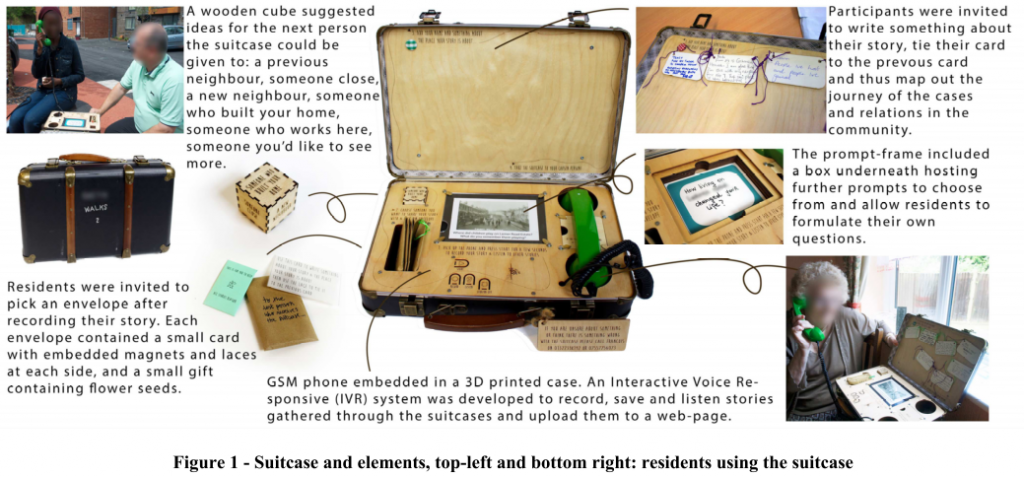Contest Hegemony!: HCI for Diverse and Plural Communities
A Critical Review of “Re-Making Places: HCI, ‘Community Building’ and Change” by Crivellaro et al. 2016
In this paper (Crivellaro et al. 2016), the authors present insights from a 11-month engagement with a housing redevelopment project. The housing association responsible for the demolition of the 1960s tower blocks with a negative public reputation and reconstruction of the new, rebranded estate was unique as it prioritised community involvement from the outset. Engagements of the authors with residents and the housing association and its engagement officer were plenty, but the work described primarily focuses on the deployment of four custom-built ‘storytelling’ suitcases (see Figure 1). The recordings revealed not only a rich history, but also the tension around a normative or a diverse understanding of ‘community’ by the housing association and the residents respectively.

The authors derive a number of conclusions from their engagement and observations. First, the suitcase intervention foregrounded that while the housing association wanted to ‘build’ a community and a better future for this ‘degraded’ neighbourhood, residents opposed this dominant view by their collection of stories that articulated not only a multitude of values, but also how these values are connected to specific places. They express lived experiences on and around the old estate and thus effectively constructed and re-made place.
The stories emancipated the notion of ‘community’ and ‘place’ from one of stable identification, a homogeneous collective of citizens, to embracing them as plural, situated, partial and contingent. This implies seeing places as spaces where different voices come together in a constructive and not simply oppositional way. Collectively they ‘work out’ what community might become instead of accepting a prescription of what it is.
In this project, the authors witnessed top-down participation that tried to idealise community by imposing a normative idea of what a ‘good’ community is onto the residents. The idea of a ‘social mix’ effectively required removal of ‘problematic’ residents and replacing them with ‘good’ families and similar accepted social groups.
The paper concludes that communities and places are ever-becoming, always ongoing and not singular, stable objects. The task of HCI is thus to facilitate a productive dialogue between the heterogeneous practices and actors instead of treating a community or place as an object to intervene or a problem to solve.
I applaud the authors for their critical perspective on community/citizen participation, both in the context of urban (re)development projects and in regards to which role HCI plays in it. In planning, participation has been criticised as a key hegemonic mechanism of neo-liberalism to stabilise state-citizen relations by providing an invited (sanctioned) space for citizens that creates the perception of (symbolic) inclusion and consent but effectively maintaining the status quo of material inequality (Miraftab 2009). This work demonstrates how HCI can counterbalance this by enabling citizens to invent their own space to resist and confront authorities. While storytelling seems seems to be a popular way in HCI to evoke a plurality of voices, I’d love to see more and diverse approaches to facilitate citizens to choose their own ways participation.
References
Crivellaro, C. et al. 2016. Re-Making Places: HCI, “Community Building” and Change. (2016).
Reflection on My Group’s Discussion on Last Week’s Session on “Experience”
My group discussed the dialogical approach to experience (McCarthy & Wright 2006). We appreciated the paper’s understanding of experience as something open and contingent and at the same time holistic and the rejection of a deterministic understanding of experience as something that can be designed upfront.
The five aspects the paper identified as important to this perspective proved to be hard to grasp. Only our collective reading, asking, discussing, writing on flip chart, and presenting to the larger group made the text accessible. After all, the aspects are fairly straightforward. ‘Relational’ understands experience as something that is constituted by the relationships that sustain it and not exists in itself. ‘Open to crossings and new becomings’ refers to experience as something that transcends established boundaries and can be particularly rich when it is new and less settled in our mind. ‘Artefacts at centre of sense-making practices’ means we understand practices and objects not isolated from each other but in an interlocking way. ‘Artefacts in narrative’ refers to the understanding of experience as embedded in a cultural narrative or backdrop. ‘Peculiarities of space and time’ finally means that our past experiences and future expectations fold into our experience of the present. Thankfully, the abstract language of the paper got broken up through many case studies that exemplified the author’s arguments. In summary, the paper is an interesting read and I believe the concepts are useful to form an open understanding of experience for our own prospective design practice, despite its resistance to give specific design guidelines.
Reference
McCarthy, J. and Wright, P.C. 2006. Dialogical Approach to Experience: Uncovering Critical Potential. Proc. The Virtual Conference 2006: Designing Digital Experience (2006).
Leave a Reply Cancel reply